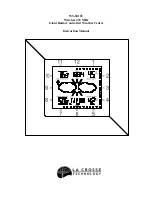
62
Activate snooze mode or end alarm signal
• The alarm signal is activated at the set alarm time; the bell symbol “ ” will flash. The backlighting will
also be activated for a few seconds.
• Pushing the button “SNOOZE/LIGHT” (1) on the top of the weather station will interrupt the alarm signal
for 5 minutes. During this time, the bell symbol “ ” will continue to flash.
Then the alarm signal is started again. This procedure can be repeated several times.
• To end the alarm signal (or snooze mode), push the button “ ” (9).
The alarm signal is automatically terminated after 2 minutes if no button is pushed.
g) Weather forecast
The weather station calculates a weather forecast for the next 12 hours from the barometric pressure de-
velopment of the last hours/days. The achievable accuracy is at about 70% to 75%. This weather forecast
uses different symbols:
Sunny
Slightly cloudy
Cloudy
Rain
Storm
Snow fall
Observe:
• If “Sunny” is displayed at night, it means a starry night.
• The display does not indicate the current weather situation, but a forecast for the next 12 hours.
• Calculation of weather forecasts only based on barometric pressure leads to a maximum accuracy of
about 70% to 75%. The actual weather on the next day may be completely different. Since the barometric
pressure measured only applies to an area with a diameter of approx. 30 - 50 km, the weather may also
change quickly. This particularly applies in mountain or high mountain areas.
Therefore, do not rely on the weather station’s forecast but gather information on site, e.g. for mountain tours.
• At sudden or larger fluctuations of barometric pressure, the display symbols are updated to show weath-
er changes. If the display symbols do not change, either the barometric pressure did not change or the
change was so slow that it could not be registered by the weather station.
• If the forecast “Sunny” or “Rain” appears, the display does not change even if the weather improves (dis-
play “Sunny”) or deteriorates (display “Rain”), since the displayed symbols already represent the two ex-
tremes.
The display symbols indicate a weather change for the better or worse, which does not have to mean sun
or rain, however, as indicated by the symbols.
• The display “Snow” (instead of “Rain”) appears if the outdoor sensor measures a temperature under -3 °C.
• After first insertion of the batteries, disregard the weather forecasts for the first 12 to 24 hours, because
to make a more exact forecast the weather station has to collect barometric pressure data at a constant
height in this period first.
• If the weather station is taken to a site at a much higher or lower altitude than the original one (e.g. from
the ground floor to an upper floor of a house), the weather station may consider this a weather change.
















































